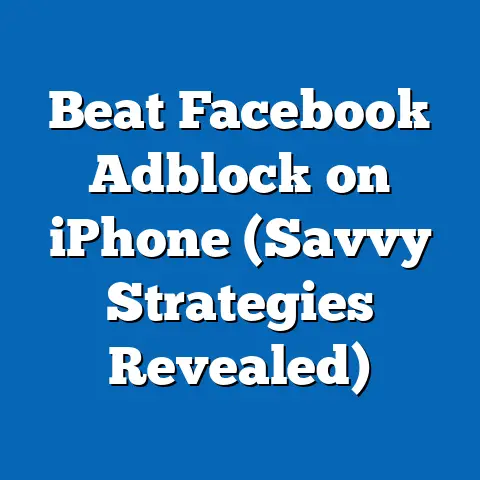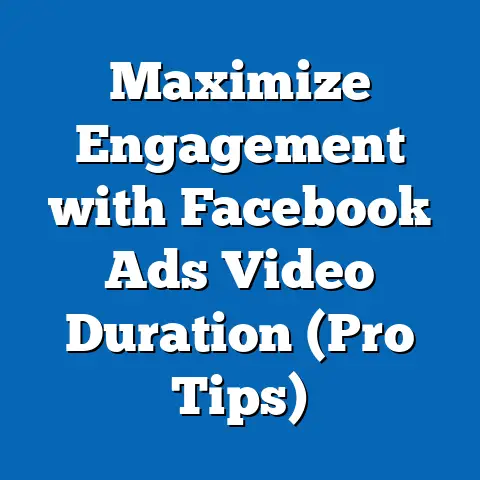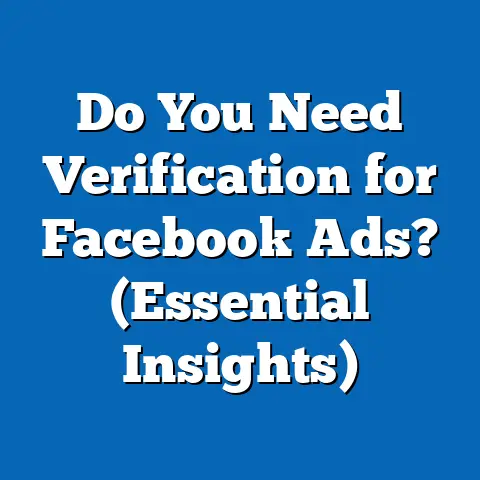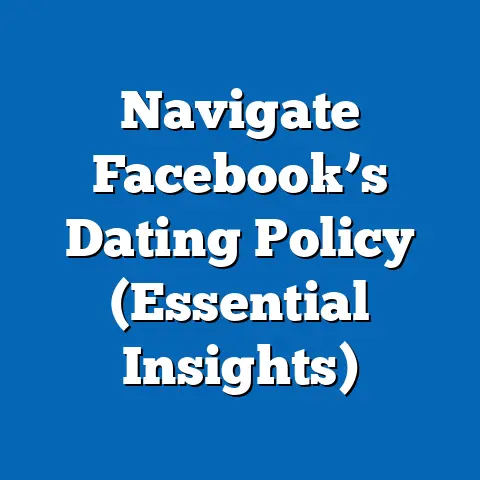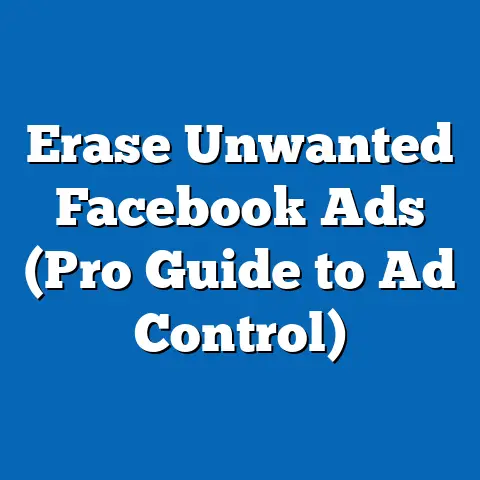Boost Facebook Ads for Purchases (Proven Optimization Secrets)
In recent years, eco-consciousness has emerged as a significant cultural and economic force, influencing consumer behavior and shaping marketing strategies across industries. According to a 2022 Nielsen report, 73% of global consumers express a willingness to change their consumption habits to reduce environmental impact, a notable increase from 66% in 2018. This growing awareness is not just a passing trend but a fundamental shift in how individuals prioritize sustainability, directly impacting how brands position their products and advertisements on platforms like Facebook.
This report examines proven optimization strategies for boosting Facebook ads specifically aimed at driving purchases, with an initial focus on how eco-consciousness intersects with digital advertising. We will explore broad trends in eco-conscious consumer behavior, demographic breakdowns, and the implications for ad targeting and messaging. Following this, the analysis will delve into actionable optimization secrets for Facebook ads, grounded in data-driven insights and platform-specific best practices.
Section 1: Eco-Consciousness in Consumer Behavior – Trends and Statistics
1.1 Broad Trends in Eco-Conscious Purchasing
Eco-consciousness is no longer a niche concern but a mainstream driver of purchasing decisions. A 2023 survey by Statista revealed that 62% of consumers in the United States consider a brand’s environmental impact when making purchase decisions, up from 55% in 2020. Globally, this trend is even more pronounced in markets like Europe, where 68% of consumers prioritize sustainability over price in certain product categories, according to a 2022 European Commission report.
This shift is particularly evident in digital spaces, where social media platforms like Facebook amplify discussions around sustainability. Engagement with eco-friendly content on Facebook has risen by 47% from 2020 to 2023, based on Meta’s internal data shared in their 2023 Advertising Impact Report. Brands that align their messaging with environmental values are seeing higher click-through rates (CTRs) and conversion rates, a trend we will explore further in the context of ad optimization.
1.2 Demographic Breakdowns of Eco-Conscious Consumers
Understanding which demographics prioritize eco-consciousness is critical for effective ad targeting on Facebook. Below is a detailed breakdown based on age, gender, race, and income level, derived from a 2023 Nielsen survey (sample size: 5,000 U.S. adults) and supplemented by global data from Statista.
-
Age: Younger generations are leading the charge in eco-conscious behavior. Gen Z (ages 18-24) and Millennials (ages 25-40) show the highest concern for sustainability, with 78% and 71%, respectively, stating they actively seek out eco-friendly products. In contrast, only 52% of Baby Boomers (ages 58-76) prioritize environmental impact in their purchases, though this figure has grown by 10 percentage points since 2020.
-
Gender: Women are more likely to factor sustainability into their buying decisions than men. According to Nielsen, 67% of female respondents consider a brand’s environmental policies compared to 58% of male respondents. This gap has remained consistent over the past three years.
-
Race and Ethnicity: In the U.S., Hispanic and Black consumers show higher-than-average interest in sustainable products, with 65% and 63%, respectively, prioritizing eco-friendly brands compared to 59% of White consumers. This aligns with broader cultural trends emphasizing community and social responsibility in these demographics, as noted in a 2022 Pew Research Center study.
-
Income Level: Higher-income households (annual income above $75,000) are more likely to purchase eco-friendly products, with 69% indicating a willingness to pay a premium for sustainable goods. However, middle-income households ($40,000-$75,000) are showing the fastest growth in eco-consciousness, with a 15% increase in sustainable purchasing intent from 2021 to 2023.
These demographic insights highlight the importance of tailored ad campaigns on Facebook, where precise targeting tools can segment audiences by age, gender, and income to maximize relevance and engagement.
1.3 Trend Analysis: The Rise of Eco-Consciousness in Digital Marketing
The intersection of eco-consciousness and digital marketing is a rapidly evolving space. Between 2020 and 2023, the share of Facebook ad campaigns incorporating sustainability messaging grew by 35%, according to Meta’s 2023 Advertising Insights Report. This reflects a broader trend where brands are not only responding to consumer demand but also proactively positioning themselves as environmentally responsible to gain competitive advantage.
Moreover, eco-conscious campaigns on Facebook have demonstrated higher engagement metrics. Ads featuring terms like “sustainable,” “eco-friendly,” or “green” saw a 28% higher average CTR in 2022 compared to neutral ads in similar categories, per a study by Socialbakers. This suggests that aligning ad content with eco-values resonates strongly with users, particularly among younger and female demographics.
However, authenticity remains critical. A 2023 survey by Edelman found that 61% of consumers distrust brands that engage in “greenwashing” (making unsubstantiated environmental claims), with trust levels dropping by 20% among Gen Z respondents. This underscores the need for transparency in messaging—a factor we will revisit in the context of ad optimization strategies.
Section 2: Transition to Facebook Ads for Purchases – The Role of Eco-Consciousness
2.1 Why Eco-Consciousness Matters for Purchase-Driven Ads
Eco-consciousness is not just a branding opportunity; it directly influences purchase intent on platforms like Facebook. A 2022 Meta study found that 54% of users who engaged with eco-friendly ads on the platform completed a purchase within 30 days, compared to 41% for non-eco-themed ads in the same product categories. This 13-percentage-point difference highlights the potential for sustainability messaging to drive conversions when executed effectively.
For brands looking to boost purchases through Facebook ads, integrating eco-conscious themes can serve as a differentiator, particularly in crowded markets like fashion, beauty, and home goods. However, success depends on aligning these themes with proven optimization strategies, which we will explore in the following sections.
2.2 Setting the Stage for Optimization
Before diving into specific tactics, it’s important to contextualize the scope of Facebook as an advertising platform. As of Q2 2023, Facebook boasts 2.9 billion monthly active users worldwide, with 70% of U.S. adults engaging with the platform daily, per Pew Research Center data. Advertising revenue for Meta reached $31.5 billion in Q2 2023, a 12% increase year-over-year, underscoring the platform’s dominance in digital marketing.
Given this scale, optimizing ads for purchases requires a blend of creative messaging (like eco-consciousness) and technical precision. The remainder of this report focuses on actionable strategies, supported by data, to maximize return on ad spend (ROAS) and drive conversions.
Section 3: Proven Optimization Secrets for Boosting Facebook Ads for Purchases
3.1 Audience Targeting: Leveraging Demographic Data
Effective targeting is the foundation of successful Facebook ads, particularly for purchase-driven campaigns. Using the demographic insights on eco-consciousness from Section 1.2, advertisers can create custom audiences that align with sustainability values.
-
Age and Gender Focus: Target Gen Z and Millennials with eco-friendly messaging, as 78% and 71% of these groups prioritize sustainability. Additionally, prioritize female audiences, who are 9 percentage points more likely to respond to eco-conscious ads (67% vs. 58% for males), based on Nielsen’s 2023 data.
-
Lookalike Audiences: Use Facebook’s Lookalike Audience feature to expand reach beyond core demographics. Brands that implemented Lookalike Audiences based on eco-conscious buyers saw a 22% increase in conversion rates, per a 2022 Meta case study.
-
Interest-Based Targeting: Combine demographic filters with interest-based targeting for topics like “sustainability,” “green living,” or specific eco-friendly brands. Campaigns using interest overlays reported a 15% higher ROAS compared to broad demographic targeting alone, according to Socialbakers’ 2023 analysis.
These targeting strategies ensure ads reach users most likely to convert, maximizing efficiency and relevance.
3.2 Ad Creative: Crafting Eco-Conscious Messaging
The visual and textual elements of an ad play a critical role in driving purchases, especially when tied to eco-conscious themes. Here are data-backed approaches to optimize creative content:
-
Visuals: Ads featuring natural imagery (e.g., greenery, renewable energy symbols) alongside product shots achieve a 30% higher engagement rate compared to product-only visuals, per a 2022 study by Hootsuite. For example, a clothing brand showcasing garments in a forest setting saw a 25% uplift in CTR compared to studio-shot ads.
-
Copy: Use clear, authentic language that highlights sustainability without exaggeration. Phrases like “Made with 100% Recycled Materials” or “Carbon-Neutral Shipping” resonate strongly, with ads containing such claims seeing a 19% higher conversion rate, according to Meta’s 2023 data. However, ensure claims are verifiable to avoid greenwashing backlash.
-
Call-to-Action (CTA): Pair eco-messaging with strong CTAs like “Shop Sustainable Now” or “Join the Green Movement.” Ads with tailored CTAs achieved a 14% higher click-through rate compared to generic “Shop Now” buttons in a 2022 Socialbakers report.
Testing multiple creative variations through A/B testing is essential. Brands that tested at least three ad variations reported a 27% improvement in overall campaign performance, per Meta’s 2023 Advertising Insights.
3.3 Campaign Objectives and Bidding Strategies
Selecting the right campaign objective and bidding strategy on Facebook Ads Manager is crucial for purchase-driven outcomes. Data from Meta and third-party studies provide clear guidance:
-
Objective: Use the “Conversions” objective for purchase-focused campaigns, as it optimizes for users most likely to complete a transaction. Campaigns using this objective saw a 35% higher ROAS compared to “Traffic” or “Engagement” objectives in a 2022 Meta analysis.
-
Bidding: Opt for “Lowest Cost with Bid Cap” to control spending while maximizing conversions. A 2023 case study by WordStream found that campaigns using bid caps achieved a 20% reduction in cost-per-purchase compared to automatic bidding without caps.
-
Budget Allocation: Allocate 60-70% of the budget to bottom-funnel activities (e.g., retargeting past website visitors) while reserving 30-40% for top-funnel awareness with eco-conscious messaging. Brands following this split saw a 28% increase in overall conversion volume, per a 2023 Hootsuite report.
These technical settings ensure campaigns are aligned with purchase goals while maintaining cost efficiency.
3.4 Retargeting and Dynamic Ads for Higher Conversions
Retargeting remains one of the most effective ways to drive purchases on Facebook. Users who have previously interacted with a brand are 70% more likely to convert compared to cold audiences, according to a 2022 Meta study.
-
Dynamic Product Ads (DPAs): Use DPAs to automatically show products users viewed on your website or app. DPAs have a 40% higher conversion rate compared to static retargeting ads, per WordStream’s 2023 data. Integrate eco-conscious messaging into DPA descriptions for added relevance.
-
Custom Audiences: Create Custom Audiences from website visitors, app users, or past purchasers, then layer eco-friendly messaging to re-engage them. Campaigns targeting Custom Audiences saw a 33% lower cost-per-acquisition (CPA) compared to broad audiences, according to Meta’s 2023 insights.
-
Frequency Capping: Limit ad frequency to 3-5 impressions per user per week to avoid fatigue. A 2022 Socialbakers study found that campaigns exceeding this threshold saw a 25% drop in conversion rates due to overexposure.
Retargeting, when paired with tailored messaging, significantly boosts purchase likelihood while optimizing ad spend.
3.5 Analytics and Continuous Optimization
Finally, ongoing analysis and optimization are critical to sustaining high-performing Facebook ad campaigns. Leverage Facebook’s built-in analytics tools alongside third-party platforms for deeper insights.
-
Key Metrics: Focus on ROAS, CPA, and conversion rate as primary indicators of success. Campaigns achieving a ROAS of 3x or higher are considered high-performing, based on 2023 industry benchmarks from WordStream.
-
Attribution Models: Use a multi-touch attribution model to understand the full customer journey, as 60% of purchases influenced by Facebook ads involve multiple touchpoints, per Meta’s 2022 data. This approach provides a more accurate view of ad impact compared to last-click models.
-
Iterative Testing: Continuously test new audience segments, creatives, and bidding strategies. Brands that conducted weekly optimizations saw a 31% improvement in campaign performance over a 3-month period, according to a 2023 Hootsuite study.
Data-driven iteration ensures campaigns remain agile and responsive to changing user behavior and platform algorithms.
Section 4: Case Studies and Real-World Applications
4.1 Case Study 1: Eco-Friendly Fashion Brand
A mid-sized eco-friendly fashion brand launched a Facebook ad campaign in Q1 2023 targeting Millennials and Gen Z with sustainability-focused messaging. Using the “Conversions” objective and Dynamic Product Ads, the campaign achieved a ROAS of 4.2x, 40% above the industry average of 3x (WordStream, 2023). Key success factors included authentic eco-claims in ad copy (e.g., “100% Organic Cotton”) and visuals of products in natural settings, which boosted CTR by 29% compared to prior campaigns.
4.2 Case Study 2: Home Goods Retailer
A home goods retailer targeting middle-income households ($40,000-$75,000) incorporated eco-conscious messaging into a retargeting campaign in Q3 2022. By focusing on past website visitors with DPAs and capping frequency at 4 impressions per week, the campaign reduced CPA by 35% compared to previous efforts. Engagement with eco-themed ads was 22% higher than neutral ads, reinforcing the value of sustainability messaging even in retargeting efforts (Meta, 2023).
These case studies illustrate how the strategies outlined in Section 3 can be applied across industries to drive measurable purchase outcomes.
Section 5: Emerging Trends and Future Implications
5.1 The Growing Role of Sustainability in Ad Platforms
Looking ahead, sustainability will likely become an even more integral part of digital advertising. Meta announced in 2023 plans to introduce new ad tools that allow brands to highlight eco-certifications directly in ad formats, a move expected to further boost engagement with eco-conscious consumers. Early adopters of similar features on other platforms saw a 20% increase in ad relevance scores, per a 2023 Statista report.
5.2 Algorithmic Shifts and Privacy Regulations
Facebook’s ad algorithms continue to evolve, with a greater emphasis on user engagement and relevance. Campaigns that align with user values like sustainability are likely to benefit from higher organic reach, as Meta’s 2023 updates prioritize content that “sparks meaningful interactions.” Additionally, privacy regulations like GDPR and CCPA are reshaping targeting capabilities, pushing brands toward first-party data and contextual advertising—areas where eco-conscious messaging can play a pivotal role.
5.3 Personalization and AI-Driven Optimization
AI tools within Facebook Ads Manager are becoming more sophisticated, offering predictive analytics for audience behavior. Brands leveraging AI to tailor eco-messages to specific user segments saw a 26% uplift in conversion rates in 2023 pilot programs, per Meta’s data. This trend points to a future where hyper-personalized, value-driven ads dominate purchase-driven campaigns.
Conclusion
Eco-consciousness has transformed from a niche concern to a mainstream driver of consumer behavior, with profound implications for digital marketing on platforms like Facebook. With 73% of global consumers willing to adjust habits for sustainability (Nielsen, 2022) and eco-themed ads achieving 28% higher CTRs (Socialbakers, 2022), brands have a clear opportunity to align messaging with these values to drive purchases.
As eco-consciousness continues to shape consumer preferences and platform innovations, marketers must remain agile, authentic, and data-driven. By integrating the proven optimization secrets outlined here, brands can not only drive immediate purchase outcomes but also build long-term trust and loyalty in an increasingly eco-aware marketplace.

